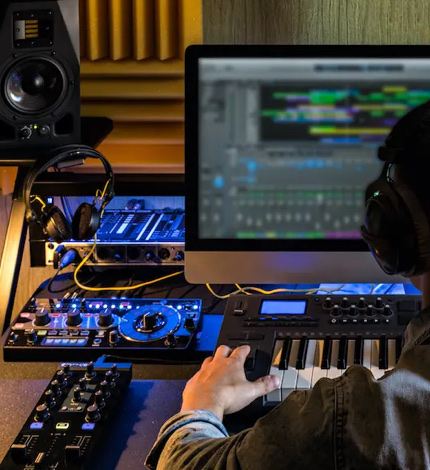Music Production Mixing with Compression
Apart from EQ, the second most used tool in music production is probably the compressor. Because unfortunately (or luckily?) we can’t make our music infinitely loud, or because some instruments can go from very soft to very loud in a very short time, we use compressors.
A compressor is a tool to control the dynamic range of a sound. You can do this by making the loudest part softer (downwards compression) or make the softest part louder (upwards compression).
Let’s start with an important example: vocals. If you look at the waveform of a vocal, you can immediately see that a vocalist has a massive dynamic range. This means that the vocals in a mix will be completely overpowering in some places and completely disappear in other spots. To make the vocal consistent and audible, we use compression.
With a compressor you will make the loudest parts of the vocal recording softer. Which in fact makes the entire vocal a bit softer. The final step is to bring the entire track back to its old level. You have now made the entire vocal recording louder.

A compressor as several parameters to adjust in order to be able to do his job properly.
First the threshold: arguably the most important setting to dial in. This setting determines at what level the compressor will start working. This is often referred to in +/. At a threshold of -20 dB a compressor will start working as soon as a part exceeds a loudness of -20 dB.
Ratio: the ratio determines how hard your compressor will compress when the threshold is exceeded. At a ratio 2:1, for every 2 decibel over the threshold only 1 decibel will be let through. At a ratio of 4:1 the compressor will only let 1 decibel through for every 4 decibels over the threshold.
In other words: the high the ratio, the harder the compressor is working.
Gain Reduction (or GR): This not a setting, but a meter that will tell you how much compression is actually happening.
Attack: Displayed in milliseconds (ms), this determines how fast the compressor starts working after the threshold is exceeded.
A fast attack will immediately start compressing the first peak. A slow attack often only starts working after the initial peak. This way you can emphasize the punch or transient of a sound.
Release: Also in milliseconds, this determines how long the compressor continues to operate after the sound has returned below the threshold. A release set too fast can result in a “pumping” sound. A slow release often sounds more natural, but can also cause the compressor to continue running for too long.
Compression has a steep learning curve before you are finally able to hear what you’re looking for. But once you’re there, don’t be afraid to think outside the box with extreme settings, which can often yield interesting results.
To read more about Music Production and how to improve the process of developing, creating and refining recorded music visit our knowledge base page Music Production Education.
